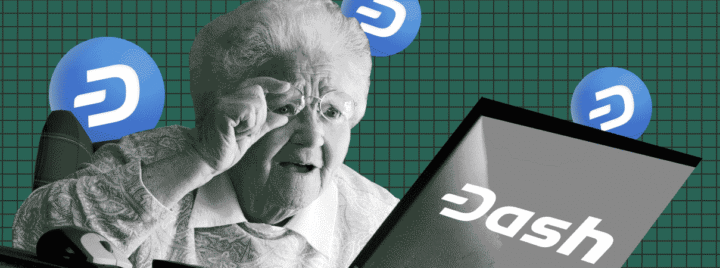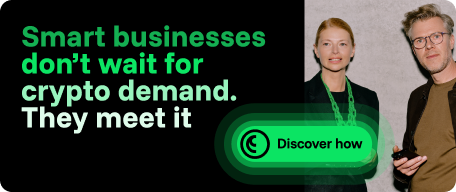Dash: First DAO and Cryptocurrency Even Your Grandma Could Use

Digital Cash, or Dash for short, is one of the most popular privacy-oriented cryptocurrencies. Besides its emphasis on confidentiality, Dash is known for its fast transaction speeds, low fees, and democratic governance model.

What Is Dash, and What Does It Have to Do with Your Grandma?
Dash is a cryptocurrency and a two-tier payment system based on an open-source blockchain. Initially, it was marketed as a privacy-oriented crypto. However, in October 2020, Fernando Gutierrez, CMO of Dash Core Group, announced a shift in focus from privacy to user-friendliness.
Key facts about the project:
- Ticker: DASH.
- Consensus algorithm: Proof-of-Work.
- Encryption algorithm: X11.
- Max supply: 18.9 million DASH.
- Network validators: miners and masternodes.
- Creator: Evan Duffield.
- Former names: Xcoin, Darkcoin.
Fun fact: It’s often mentioned in Dash’s materials that Evan Duffield envisioned a cryptocurrency so easy that “even your grandma could use it.” He actually said these words during his presentation of Dash Evolution at the Bitcoin Wednesday conference in 2015.

Project Timeline
The main events in the history of Dash development:
- January 18, 2014: XCoin launched.
- February 28, 2014: name changed to Darkcoin.
- March 25, 2015: rebranded as Dash.
- January 22, 2016: introduction of Dash Evolution, the world’s first decentralized open-source API.
- 2018: Dash became widely used in Venezuela and Colombia as a payment method during periods of extreme inflation of local currencies.
- August 6, 2018: the number of masternodes on Dash’s mainnet reached a historical high of 4,939.
- October 2018: Venezuela’s national cryptocurrency, Petro, switched its hashing algorithm to X11, copying Dash’s technology and highlighting the project’s popularity in Latin America.
- 2020: the launch of KRIP smartphones with a pre-installed Dash wallet.
- July 2022: staking in fractional masternodes was introduced in partnership with CrowdNode, with a participation threshold of 0.5 DASH.
- July 29, 2024: full launch of Dash Platform on the mainnet, providing a development environment for decentralized applications.
Of course, these are just some of the key milestones. For more on the project’s technical advancements, both current and future, check out Dash’s roadmap.

Features of Dash Blockchain
Among its features stand out the following:
- high transaction speed and low fees;
- enhanced privacy for transactions;
- use of multiple hashing algorithms;
- lower resource consumption for mining compared to many other cryptocurrencies;
- a two-tier network structure and democratic governance.
Some of Dash’s unique aspects deserve a closer look.
Two-Tier Network Structure
Bitcoin, for example, uses a typical one-tier system where miners handle all the data processing. In Dash, data processing is split between regular miners and masternode operators.
A masternode is a powerful server that stays connected to the network most of the time. To become a masternode, a user must put up a “deposit” of 1,000 DASH, which as of mid-October 2024, amounts to roughly $22,600. This deposit can be withdrawn at any time, but doing so will remove the masternode status.
Rewards for processing transactions and the responsibility are equally divided between regular miners and masternode operators, 45% each. Another 10% goes into a network funding pool.
Speed, Privacy, and Fees
Dash offers two transaction mechanisms: InstantSend and PrivateSend. InstantSend increases transaction speeds, while PrivateSend boosts privacy of transactions and users.
Initially, Dash was positioned as a “truly anonymous cryptocurrency,” but privacy eventually became less of a priority. In 2020, Fernando Gutierrez explained that the PrivateSend function is based on CoinJoin technology. While it complicates data analysis tools’ ability to link transactions to specific network participants, it doesn’t guarantee complete anonymity.
The real level of anonymity of cryptocurrencies was addressed by CP Media in a separate article.
For cases where transaction speed is crucial, transactions are confirmed by masternodes rather than miners, resulting in near-instant processing. The fee for such transactions is higher, ranging from $0.005 for a regular transfer to $0.01 for an expedited one. Standard transactions are processed in about 2–3 minutes.
Hashing Algorithms and Mining Features
Dash employs a series of 11 different hash functions — BLAKE, BMW, Groestl, JH, Keccak, Skein, Luffa, Cubehash, Shavite, SIMD, and Echo. These are combined within the cryptographic X11 algorithm, which is the foundation of the cryptocurrency.
Initially, the X11 technology was designed to make mining with specialized hardware more difficult, allowing regular users to participate. However, interest in the cryptocurrency led to the gradual adaptation of ASIC equipment to the X11 algorithm starting in 2016. As a result, almost 100% of Dash’s network hash rate is now provided by ASIC devices, making CPU or GPU mining for DASH economically unviable.
Democracy and Security
Dash claims the title of the first decentralized autonomous organization (DAO). All decisions regarding the development and funding of the organization are made through a voting process on the official website.
Any community member can submit a proposal for a vote, with an entry fee of 5 DASH.
Masternode operators can then vote to accept or reject the proposal. If a proposal receives at least 10% more “yes” votes than “no,” it moves forward for implementation. This governance model allows for faster decision-making and greater involvement from key network participants.
For example, the decision to increase block sizes from 1 MB to 2 MB was approved within 24 hours, with 99% participation from masternodes. In contrast, a similar proposal in the Bitcoin community was debated for two years without consensus. Masternode operators have a financial stake in the network’s development, meaning they’re likely to make decisions that favor its growth.
The required deposit of 1,000 DASH serves as a guarantee against centralizing power in the hands of a few and also provides protection against 51% attacks. According to DASH Ninja, as of the time of writing, there are 2,737 active masternodes on the network. However, there’s one important nuance to this, which we’ll discuss below.

Criticism: Instamine and “Naive Marketing”
During the early days of Dash, the network experienced an instamine event, leading to an unfair distribution of assets. Around 1.8 million DASH tokens, roughly 10% of the total supply, were mined in the first 48 hours. The beneficiaries were network founder Evan Duffield and one anonymous miner. This incident was caused by a coding error, which Duffield fixed after noticing. He then proposed a restart of the cryptocurrency, but by that time some tokens had already been distributed to community members. The proposal was rejected by the network, and everything remained as is.
The concentration of such a large portion of DASH among a small number of participants opens the possibility that more than 51% of masternodes could be controlled by a single person or a group of early participants. While this can’t be verified, decisions made “collectively” could, in such a situation, benefit specific individuals. This is the nuance.
Many users have expressed doubts about certain development expenditures approved via voting. The most prominent example is from 2018, when the community spent over $10 million on promoting Dash. These expenditures included:
- purchasing a branded fighter jet;
- advertising with top MMA fighters;
- sponsoring a music festival;
- costly collaborations with little-known bloggers;
- developing a new website at a cost of $500,000;
- creating an unpopular platform for purchasing marijuana in the U.S., among other questionable marketing initiatives.
This situation has led some to believe that many of these costly “naive projects” may have been a way to launder community funds.

What’s Verdict on Dash?
Dash is an innovative and groundbreaking crypto project that has continued to evolve actively over the past decade. Although its focus has shifted from privacy to user-friendliness, DASH remains one of the largest cryptocurrencies known for enhanced privacy features.
Since 2020, major centralized exchanges have delisted the asset, and certain jurisdictions like the EU and South Korea have banned its use due to privacy concerns, which prevent full transparency in network activities. However, Dash remains popular among users of DEXs and continues to see significant adoption in Latin American countries.
The main factor keeping Dash alive and thriving is its active and dedicated community. Thanks to their efforts, Dash is continually evolving, striving to become so user-friendly that even your grandma could use it.











